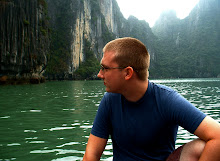Wednesday, February 07, 2007
Monday, January 15, 2007
Distractions
If you're reading this then I probably told you that I finally updated my blog, since any poor souls who had been checking back of their own volition to see if I updated it have long ago given up hope. I'll give no excuse for my leave of absence (though I considered at least four or five legitimate ones, and another half a dozen that were complete flights of fancy, but might have made good reading) and merely state that I have been distracted by one thing or another for many moons. Not that there's been an overwhelming clamor for more updates. There has, however, been a grassroots push for at least more pictures. In an effort to oblige, I will be posting pictures with the minimum amount of captioning and commentary (admit it, you skip through the text to look at the pictures anyway) and will make no attempt to put any sort of editorial perspective on the last few months. Over the next two days I hope to add many pictures, but who knows, I may become distracted!
Thursday, October 12, 2006
Kanchanaburi Part III
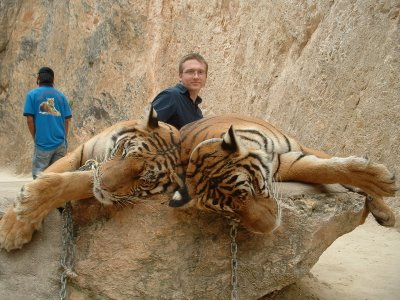
The beginning of our third day in Kanchanaburi was spent sleeping. The hiking and the falls from the day before had worn us out. Around noon we surfaced and got breakfast (more banana pancakes) and then went to book a trip out to the Tiger Temple. For 120 Baht a person we would be shuttled to and from the Tiger Temple from our Guest House. And we were warned not to where any bright colors or strong perfume. "Tigers no like." The Temple has a name in Thai, Wat Pa Luangta Bua, but even the Thais all seem to refer to it as the Tiger Temple. The name comes from the Abbot of the temple, who started taking in orphaned tigers from the nearby forests. There are now more than eighteen tigers (and a leopard) living on the grounds of the Temple, and it is a major tourist attraction. The temple also started taking in orphaned wild animals of all types, and its grounds are now teeming with animals ranging from wild pigs to wild water buffalo. The Temple is about an hours Sawng Thaew ride from where we were staying, at the base of one of the several small mountain ranges that surround Kanchanaburi. We arrived around three thirty, which was fine because the tigers apparently only come out after two thirty. My guess is that they have to be well fed first. After paying a 300 Baht mandatory donation to the temple and its Tigers, one is pretty much set free to walk about the temple grounds. We were perhaps ten feet past the front gate when we spotted some Asian short-tailed deer and small wild horses. During the afternoon the Tigers, or at least those that have been behaving themselves around tourists, are taken into a canyon that has only one exit and entrance. At the bottom of this canyon the majority of the tigers are put on chains and allowed to roam as much as their relatively short chains will let them. Some are allowed off the chains, if the monks are around. Tourists are allowed down into the canyon where they can get pictures taken with the tigers. A volunteer leads you from tiger to tiger, while another volunteer takes your picture with your own camera.
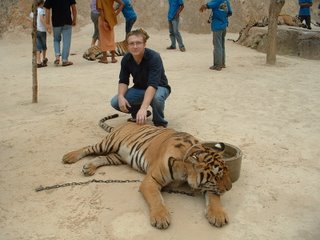 It seemed to be an efficient system that kept the tourists (all Farang) happy, as well as the tigers unruffled.
It seemed to be an efficient system that kept the tourists (all Farang) happy, as well as the tigers unruffled.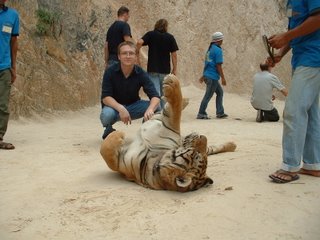

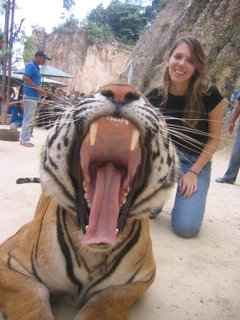
I would be lying to you if I said I approached these dozen tigers without a little trepidation. Being in the presence of an animal that is well documented to be one of the most efficient predators in the world is always a little intimidating. The fact that there was nothing between me and them that would really mean anything if they did decide to taste test me, made the adrenaline pump all the more. But most of the tigers where perfectly happy to continue napping through all of this, and those that weren't were generally well behaved. I was unmolested during my time amongst the tigers, and seeing two very little girls straddle a very
 awake tiger that perhaps weighed three times what they did made me feel a little silly for being on edge around them. We stuck around the canyon for a little while, watching tourists interact with the tigers. One tiger, the male (guessing) who was unchained, became rather ornery all of a sudden and began growling and making a bit of a ruckus. Of the three dozen or more tourists down in the canyon at the time I'd say half of them literally froze when the tiger growled. It was an impressive noise that sounded as if it were coming from surround sound speakers. In short, it was LOUD! After leaving the tigers (and most of the tourists) in the canyon, we walked the rest of the grounds where we saw dozens of wild pigs, cows, peacocks, roosters, and water buffalo. There were also some large cages that housed more tigers, a leopard, and a large bear-like sloth creature that was sort of difficult to identify. Not long after, the tigers and their entourage of volunteer handlers, monks, and tourists made the walk from the canyon to their cages up above us. They had to walk right by us, but before they could, a monk began picking up sticks and stones and hurled them at the other animals so as to make them get out of the way. Apparently the tigers will lose interest in going to their cages and attempt to nab an extra snack if given the opportunity. After the tigers had passed us, the rest of the animals, and we're talking a lot of animals, bum rushed the dirt roadway we had been standing on, for feeding time.
awake tiger that perhaps weighed three times what they did made me feel a little silly for being on edge around them. We stuck around the canyon for a little while, watching tourists interact with the tigers. One tiger, the male (guessing) who was unchained, became rather ornery all of a sudden and began growling and making a bit of a ruckus. Of the three dozen or more tourists down in the canyon at the time I'd say half of them literally froze when the tiger growled. It was an impressive noise that sounded as if it were coming from surround sound speakers. In short, it was LOUD! After leaving the tigers (and most of the tourists) in the canyon, we walked the rest of the grounds where we saw dozens of wild pigs, cows, peacocks, roosters, and water buffalo. There were also some large cages that housed more tigers, a leopard, and a large bear-like sloth creature that was sort of difficult to identify. Not long after, the tigers and their entourage of volunteer handlers, monks, and tourists made the walk from the canyon to their cages up above us. They had to walk right by us, but before they could, a monk began picking up sticks and stones and hurled them at the other animals so as to make them get out of the way. Apparently the tigers will lose interest in going to their cages and attempt to nab an extra snack if given the opportunity. After the tigers had passed us, the rest of the animals, and we're talking a lot of animals, bum rushed the dirt roadway we had been standing on, for feeding time.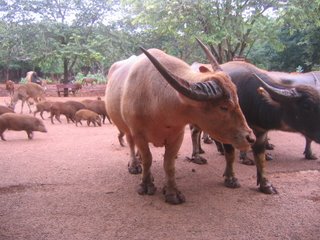 After watching the pigs and peacocks duel over some grain on the ground, it was time to head home. It was a very interesting place, in all regards. There were several volunteers there who were farang, and I asked how they ended up there. The temple apparently takes farang volunteers from all over the world on a regular basis. The man I spoke to had been there for three months after a friend visited and told him about it. I asked if the tigers were always so docile and tame. The response was, "Generally, unless they get a bit nippy. You get a few bites and scratches."
After watching the pigs and peacocks duel over some grain on the ground, it was time to head home. It was a very interesting place, in all regards. There were several volunteers there who were farang, and I asked how they ended up there. The temple apparently takes farang volunteers from all over the world on a regular basis. The man I spoke to had been there for three months after a friend visited and told him about it. I asked if the tigers were always so docile and tame. The response was, "Generally, unless they get a bit nippy. You get a few bites and scratches."Sounds like a cool place to volunteer. I'm considering it.
Wednesday, October 11, 2006
Kanchanaburi Part II
The second day in Kanchanaburi started early with a trip to the bus station to catch a bus to Erawan National park. We were headed there to see the famous Erawan falls, seven steps of falls that run out of the mountains and form a tributary of the River Kwai. The bus from Kanchanaburi was a Mercedes Benz model from the 1960s, and we traveled the whole distance with the doors open and the windows down, as there was no air conditioning on this bus. It took a little more than an hour to get to the park, and once there it was a short hike, about 700m, to the first step of the falls.  They were extremely impressive. It was much like stepping into a postcard or one of a thousand inspirational posters found in college dorms across the country. The place was gorgeous in every way, and unlike many other tourist attractions I've seen in this country, this place was swarming with locals. The blue hue of the water, due to the calcium carbonate in the water from the limestone it is eroding, made the sight even more surreal. We hiked up nearly a kilometer and a half to the sixth step, but found the rest of the trail flooded, due to the recent
They were extremely impressive. It was much like stepping into a postcard or one of a thousand inspirational posters found in college dorms across the country. The place was gorgeous in every way, and unlike many other tourist attractions I've seen in this country, this place was swarming with locals. The blue hue of the water, due to the calcium carbonate in the water from the limestone it is eroding, made the sight even more surreal. We hiked up nearly a kilometer and a half to the sixth step, but found the rest of the trail flooded, due to the recent rains and it already being the high water season. We decided to hike down to the fifth step and go for a swim. In the pools beneath each fall were schools of fish I have yet to identify, though they were very aggressive and would not hesitate to give your toes a nibble, though they weren't painful, they made swimming a bit interesting.
rains and it already being the high water season. We decided to hike down to the fifth step and go for a swim. In the pools beneath each fall were schools of fish I have yet to identify, though they were very aggressive and would not hesitate to give your toes a nibble, though they weren't painful, they made swimming a bit interesting.  There were signs along the trail that indicated that monkeys were common (and we were NOT to feed them) but we saw no monkeys, nor anything else besides the fish and a few skinks. By the time we had decided to head down the trail again to pick up the last bus out of the park, it had started to rain. By the time we reached the second step, it was pouring, and continued to do so till long after we had reached our bus. The falls had already swelled by nearly 50% by the time we reached the first step. I guess that's why they call it a rainforest.
There were signs along the trail that indicated that monkeys were common (and we were NOT to feed them) but we saw no monkeys, nor anything else besides the fish and a few skinks. By the time we had decided to head down the trail again to pick up the last bus out of the park, it had started to rain. By the time we reached the second step, it was pouring, and continued to do so till long after we had reached our bus. The falls had already swelled by nearly 50% by the time we reached the first step. I guess that's why they call it a rainforest.

Tomorrow: The Tiger Temple
 They were extremely impressive. It was much like stepping into a postcard or one of a thousand inspirational posters found in college dorms across the country. The place was gorgeous in every way, and unlike many other tourist attractions I've seen in this country, this place was swarming with locals. The blue hue of the water, due to the calcium carbonate in the water from the limestone it is eroding, made the sight even more surreal. We hiked up nearly a kilometer and a half to the sixth step, but found the rest of the trail flooded, due to the recent
They were extremely impressive. It was much like stepping into a postcard or one of a thousand inspirational posters found in college dorms across the country. The place was gorgeous in every way, and unlike many other tourist attractions I've seen in this country, this place was swarming with locals. The blue hue of the water, due to the calcium carbonate in the water from the limestone it is eroding, made the sight even more surreal. We hiked up nearly a kilometer and a half to the sixth step, but found the rest of the trail flooded, due to the recent rains and it already being the high water season. We decided to hike down to the fifth step and go for a swim. In the pools beneath each fall were schools of fish I have yet to identify, though they were very aggressive and would not hesitate to give your toes a nibble, though they weren't painful, they made swimming a bit interesting.
rains and it already being the high water season. We decided to hike down to the fifth step and go for a swim. In the pools beneath each fall were schools of fish I have yet to identify, though they were very aggressive and would not hesitate to give your toes a nibble, though they weren't painful, they made swimming a bit interesting.  There were signs along the trail that indicated that monkeys were common (and we were NOT to feed them) but we saw no monkeys, nor anything else besides the fish and a few skinks. By the time we had decided to head down the trail again to pick up the last bus out of the park, it had started to rain. By the time we reached the second step, it was pouring, and continued to do so till long after we had reached our bus. The falls had already swelled by nearly 50% by the time we reached the first step. I guess that's why they call it a rainforest.
There were signs along the trail that indicated that monkeys were common (and we were NOT to feed them) but we saw no monkeys, nor anything else besides the fish and a few skinks. By the time we had decided to head down the trail again to pick up the last bus out of the park, it had started to rain. By the time we reached the second step, it was pouring, and continued to do so till long after we had reached our bus. The falls had already swelled by nearly 50% by the time we reached the first step. I guess that's why they call it a rainforest.
Tomorrow: The Tiger Temple
Kanchanaburi Part I
I know, I know, I have been completely remiss in getting more posts up on the blog. I have no excuse. Instead, I will make a peace offering. Four posts in four days, each detailing a day of my recent long weekend in the province of Kanchanaburi. Deal? Hope so.
Our first day in Kanchanaburi has to be prefaced by our arrival and subsequent first evening there. If every trip has to have its low point, we got it out of the way early. The bus ride from Bangkok to Kanchanaburi was rainy but uneventful, and we were in a Sawng Thaew (A pickup truck turned taxi with benches in the back) within moments of getting off the bus. The guest house that we had intended to stay at was full, no room at the inn. Our second choice was more than happy to accommodate us, and the room they gave us was fairly average for the area and price range. A minor setback, but no big deal. We dropped off our bags and went in search of food. The town of Kanchanaburi is fairly large, but there is one main road that runs along the Kwai River from the infamous bridge to the heart of town. Along this main road are literally dozens of Farang owned bars (mostly of the seediest nature and pushing as many prostitutes as drinks) and nearly a dozen or more "guest houses" which are essentially Farang hotels. For anywhere from 150 to 300 Baht a night one gets a clean bed in a clean room with a door that locks, a fan, a clean bathroom that doubles as a shower, and a toilet that is of the gravity-flush variety. More than adequate. There are nicer places on the river, often offering more substantial plumbing and even air conditioning, but they serve the minority clientel. Most Farang here, and there were many, were of the European backpacker variety, and they follow a code that demands the least amount of luxury. We were a ways from the center of town so there were few street vendors and restaurants, though plenty of bars that served food, but they all had a few older white men sitting at the bars staring lazily at beers and generally looking like men fishing for an opportunity. The first restaurant that wasn't decorated horrendously and was without any white people received our patronage. I had Phad Siew Moo (Which in Thai is pronounced Pad Si-ooooooo Moooooo and is really ridiculous sounding to someone who has spoken English their whole lives, and even more difficult to actually say) My fried big noodles with pork was amazing. I would soon discover that the Thai food in Kanchanaburi was perhaps some of the best in all of Thailand. We were fed, and were tired, so we headed back to our room. Things were going very well. That is until we realized two things: just how hard and uncomfortable the bed in our room was, and the proximity of our room to several roosters next door and the road outside. Needless to say there was little or no sleep to be had, and several plots were hatched that would have resulted in the untimely demise of said roosters, had they come to fruition. We checked out as soon as someone appeared to man the front desk, and hiked back up the road to what had been our first choice of temporary residence, Apple Guest House. If we were unable to get a room there, again, there were at least six others along the way we could check out. But as luck would have it, there was a room to be had at Apple, and though it was a bit more expensive than the previous establishment, we were exhausted and cranky and took it.
After tossing our bags into our new (and much improved) room, we dropped into Apple's restaurant for breakfast. We had banana pancakes. They were amazing, so good in fact that the Lonely Planet guide to Thailand made mention of them in their most recent edition. After breakfast we hiked down the main road to see the bridge and the market there. It was a bit of a longer hike than we had anticipated, but we had just eaten a lot of banana pancake, so it was probably just as well. The Bridge over the River Kwai (which is how the Thais refer to it, anxious to encourage its notoriety) is really much smaller than I had anticipated.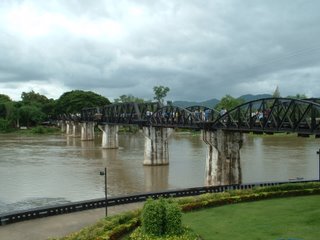 Having seen the movie on more than one occasion (the film was not shot in Thailand at all, but in nearby Burma) I expected it to be somewhat larger. In reality, the bridge that stands there today is only partially the bridge that was built in World War II by POWs and local slave labour, large sections of it were rebuilt by the Thai government (the engineering contract went to a Japanese firm, ironically) after the war. It was used for a little more than a decade and then the rail on the line was ripped up and now the bridge remains as a monument to the many Thais, Laos, Indians, Burmese, and (mostly) British POWs who died building what is called "The Death Railway" Perhaps what I found most interesting about the bridge was on a placard some fifty feet away from the bridge itself that revealed that after the war, the British retained control of the bridge, and actually sold it to the Thai government for 50 million Baht. Given the traditionally low stature of the Baht and the rise of inflation, this was an incredible sum of money for Thailand to have paid for a bridge that was already in their country and had been partly built by their own hands. All in all, it was an interesting piece of history to see first hand, memorialized in a way that was very different from the way the United States tends to memorialize such things.
Having seen the movie on more than one occasion (the film was not shot in Thailand at all, but in nearby Burma) I expected it to be somewhat larger. In reality, the bridge that stands there today is only partially the bridge that was built in World War II by POWs and local slave labour, large sections of it were rebuilt by the Thai government (the engineering contract went to a Japanese firm, ironically) after the war. It was used for a little more than a decade and then the rail on the line was ripped up and now the bridge remains as a monument to the many Thais, Laos, Indians, Burmese, and (mostly) British POWs who died building what is called "The Death Railway" Perhaps what I found most interesting about the bridge was on a placard some fifty feet away from the bridge itself that revealed that after the war, the British retained control of the bridge, and actually sold it to the Thai government for 50 million Baht. Given the traditionally low stature of the Baht and the rise of inflation, this was an incredible sum of money for Thailand to have paid for a bridge that was already in their country and had been partly built by their own hands. All in all, it was an interesting piece of history to see first hand, memorialized in a way that was very different from the way the United States tends to memorialize such things.
That evening, we signed up for a trip out to the Karen Village for some close encounters with some elephants and their mahouts. We did this through one of the many Trek and Tour companies set up near the bars and guest houses, offering tour packages of all kinds and lengths to see many of Kanchanaburi's more notable sights. Our "guide" was E'ou (spelling is phonetic and not based on anything I ever saw written) and as far as we could tell he was a nearby college student and was likely a relative of the woman we signed up with. He drove us in another Sawng Thaew to the Karen village about an hour away. The Karen, who are half Thai and half Burmese, are elephant people. Every male born into the community is a potential mahout. I'm assuming a certain amount of sexism exists here, since I saw no female mahouts, but I could be wrong. Once we arrived at the village, after turning off the main road and traveling a kilometer or two down a dirt road, we were essentially set loose in the village (and by village I refer to a single row of perhaps a dozen wood huts) and we were soon grabbed by a young boy with a baseball cap that was far too large for his head. The boy led us by hand down a path away from the village to where (we supposed) there would be elephants. The boy spoke no English but seemed to be encouraging us to follow him and leave our friend E'ou behind, which we did. We had walked no more than a hundred yards when we came over a berm and were only fifteen feet from a juvenile elephant, chained to a post. It is perhaps fair to say that we were a bit in awe of this creature before us who had obviously made ample use of the mud provided by the recent rain. She (we would later be told it was a five year old female) was covered in mud and not allowing our presence to stop her from romping in it. An older white women of unknown origins appeared and proceeded to talk to us and the elephant, though mostly to the elephant, chastising it for being so muddy. She unchained the elephant and it willingly lumbered after her, and we were quick to follow them, along with our little companion with the ungainly hat. We watched as she hosed the elephant down and then proceeded to show us some of the tricks it could do, which included hula-hooping with its trunk, playing a harmonica and dancing (no wonder the circus employed these creatures!), and taking money from one person and putting it in another persons pocket. Which I imagine is the first trick any decent mahout teaches its elephant. E'ou then reappeared and told us to go down to the river, we would get a chance to help bathe an elephant.
which we did. We had walked no more than a hundred yards when we came over a berm and were only fifteen feet from a juvenile elephant, chained to a post. It is perhaps fair to say that we were a bit in awe of this creature before us who had obviously made ample use of the mud provided by the recent rain. She (we would later be told it was a five year old female) was covered in mud and not allowing our presence to stop her from romping in it. An older white women of unknown origins appeared and proceeded to talk to us and the elephant, though mostly to the elephant, chastising it for being so muddy. She unchained the elephant and it willingly lumbered after her, and we were quick to follow them, along with our little companion with the ungainly hat. We watched as she hosed the elephant down and then proceeded to show us some of the tricks it could do, which included hula-hooping with its trunk, playing a harmonica and dancing (no wonder the circus employed these creatures!), and taking money from one person and putting it in another persons pocket. Which I imagine is the first trick any decent mahout teaches its elephant. E'ou then reappeared and told us to go down to the river, we would get a chance to help bathe an elephant.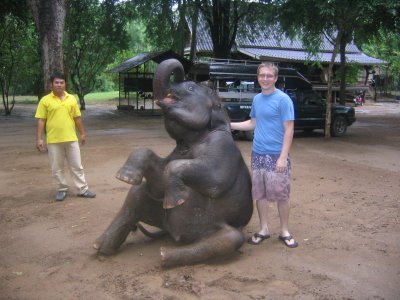
Now here I feel I must insert a disclaimer. My experience with the elephants was not unique in the sense that we were special in any way by being allowed to do such a thing. We had paid the guide a sum of money, some of which I am quite sure went into the pocket of the mahout and maybe even the village as a whole; it was built into the tour company's fee, I have no doubt. I am sure that what I experienced happens every day there and at many places like it. That being said, it was a truly awesome experience, well worth whatever money made it possible, and certainly something I would highly recommend to those who get such an opportunity. They say the experience bought and paid for is less sweet than the one stumbled upon or striven for, but in this case, I disagree. End of disclaimer.
We walked down to the river (not sure if this was the River Kwai, or one of its many tributaries, though this water was moving faster and cleaner than the Kwai had at the bridge and hour away) where there was an elephant launch and dock. That's really the only way to describe it: a ramp that went straight into the river and a wooden pier that went out over the water that an elephant could walk up to and its back would be level with the pier. Our elephant, whose name was Ghakani (again, guessing at an English spelling) was already lumbering down the ramp to the water. The first thing that struck me was her size, appreciable only by being compared to a large piece of mining equipment, and the second thing that struck me after she was in the water, was how fast and deep the river was. I looked for life jackets and was relieved to see a few draped over the railing of the pier. At least if I was swept of the back of the elephant I would float downstream in a leisurely manner. After donning a life jacket I simply walked to the edge of the pier where the elephant and mahout were waiting, and got on. The mahout was a youngish looking guy, who would later reveal himself to be nineteen, and would also reveal the elephant to be twenty-two.
himself to be nineteen, and would also reveal the elephant to be twenty-two.
He'd known the elephant a while.
As soon as I was onboard I was armed with a scrubbing brush and a squeeze bottle of some kind of soap, and we headed out into the river. A few elephantine steps towards the center of the river and the water was up past my waist and nearly over the elephant's head. At this point the mahout, who had been in front of me, near the elephant's neck and sitting on its shoulders, climbed over me and instructed me to take the front position. This was perhaps something the elephant had been waiting for, because she immediately took advantage of her mahouts distraction and kneeled. This left the mahout and I (the mahout was not wearing a life-vest, though I imagine he was pretty good swimmer) floating where once there had been an elephant beneath us. Elephants can hold their breath for a considerable amount of time, and I was afraid we had drifted away from her when she finally stood back up beneath us. My seat returned, I began to soap and scrub. Ghakani was enjoying having an idiot Farang in the power position (a mahout controls a tamed elephant with a sharp steel hook called an ankusha that is applied in various manners to the elephant's head and ears) and was kneeling and sometimes laying down in the river, and thus completely disappearing beneath me. This was unnerving, and I'm not going to lie, the mahout sounded more than a little ticked about it himself. She kept coming back up beneath us however, and on one occasion she came up from having gone completely out from under us, and I have a very distinct memory of seeing her massive head and ears coming through the water at me. It was a sight I will not soon forget. Whenever Ghakani did get her ears above water, the mahout behind me would shout all sorts of monosyllabic words in Thai that I'm sure were as much curses as instructions, since several other mahouts back on shore were watching and laughing, I think, less at me than at their comrade who was having trouble with his elephant. Ghakani headed for shore after she had dunked us a half a dozen times, and on the way in she spewed a trunk-full of water over her head at us, which I caught full in the face. It was amazing. For someone whose favorite ride at Disneyland had always been the Jungle Cruise, this was everything I had imagined it to be. When we, and the elephant, had dried off, the mahout saddled her (which is like strapping a small garden bench to her back) and we took her for a stroll through the nearby hill jungle. The mahout sat on her shoulders and neck and drove, while we sat up in the bench and listened to the mahout butcher American rock'n'roll and Jingle Bells. As we returned to the village, the mahout suddenly dropped off the elephant and said, in the first english we had heard from him all evening, "Okay, you driver now." So I got to climb down off the bench/saddle and ride Ghakani's neck, which requires a certain limberness of the hips, as her shoulder blades where moving up and down with a great deal of force beneath me. It was a very cool experience.
on the way in she spewed a trunk-full of water over her head at us, which I caught full in the face. It was amazing. For someone whose favorite ride at Disneyland had always been the Jungle Cruise, this was everything I had imagined it to be. When we, and the elephant, had dried off, the mahout saddled her (which is like strapping a small garden bench to her back) and we took her for a stroll through the nearby hill jungle. The mahout sat on her shoulders and neck and drove, while we sat up in the bench and listened to the mahout butcher American rock'n'roll and Jingle Bells. As we returned to the village, the mahout suddenly dropped off the elephant and said, in the first english we had heard from him all evening, "Okay, you driver now." So I got to climb down off the bench/saddle and ride Ghakani's neck, which requires a certain limberness of the hips, as her shoulder blades where moving up and down with a great deal of force beneath me. It was a very cool experience.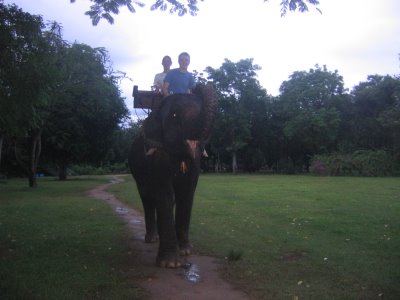
To top off the evening, I was given a bag of bananas to feed to her after we returned and had dismounted. I made the very stupid mistake of asking, "Do I peel them or give them to her whole?" The mahout was kind enough to only grin. All in all, it was a great evening with the elephants.

Tomorrow: The Erawan Falls
Our first day in Kanchanaburi has to be prefaced by our arrival and subsequent first evening there. If every trip has to have its low point, we got it out of the way early. The bus ride from Bangkok to Kanchanaburi was rainy but uneventful, and we were in a Sawng Thaew (A pickup truck turned taxi with benches in the back) within moments of getting off the bus. The guest house that we had intended to stay at was full, no room at the inn. Our second choice was more than happy to accommodate us, and the room they gave us was fairly average for the area and price range. A minor setback, but no big deal. We dropped off our bags and went in search of food. The town of Kanchanaburi is fairly large, but there is one main road that runs along the Kwai River from the infamous bridge to the heart of town. Along this main road are literally dozens of Farang owned bars (mostly of the seediest nature and pushing as many prostitutes as drinks) and nearly a dozen or more "guest houses" which are essentially Farang hotels. For anywhere from 150 to 300 Baht a night one gets a clean bed in a clean room with a door that locks, a fan, a clean bathroom that doubles as a shower, and a toilet that is of the gravity-flush variety. More than adequate. There are nicer places on the river, often offering more substantial plumbing and even air conditioning, but they serve the minority clientel. Most Farang here, and there were many, were of the European backpacker variety, and they follow a code that demands the least amount of luxury. We were a ways from the center of town so there were few street vendors and restaurants, though plenty of bars that served food, but they all had a few older white men sitting at the bars staring lazily at beers and generally looking like men fishing for an opportunity. The first restaurant that wasn't decorated horrendously and was without any white people received our patronage. I had Phad Siew Moo (Which in Thai is pronounced Pad Si-ooooooo Moooooo and is really ridiculous sounding to someone who has spoken English their whole lives, and even more difficult to actually say) My fried big noodles with pork was amazing. I would soon discover that the Thai food in Kanchanaburi was perhaps some of the best in all of Thailand. We were fed, and were tired, so we headed back to our room. Things were going very well. That is until we realized two things: just how hard and uncomfortable the bed in our room was, and the proximity of our room to several roosters next door and the road outside. Needless to say there was little or no sleep to be had, and several plots were hatched that would have resulted in the untimely demise of said roosters, had they come to fruition. We checked out as soon as someone appeared to man the front desk, and hiked back up the road to what had been our first choice of temporary residence, Apple Guest House. If we were unable to get a room there, again, there were at least six others along the way we could check out. But as luck would have it, there was a room to be had at Apple, and though it was a bit more expensive than the previous establishment, we were exhausted and cranky and took it.
After tossing our bags into our new (and much improved) room, we dropped into Apple's restaurant for breakfast. We had banana pancakes. They were amazing, so good in fact that the Lonely Planet guide to Thailand made mention of them in their most recent edition. After breakfast we hiked down the main road to see the bridge and the market there. It was a bit of a longer hike than we had anticipated, but we had just eaten a lot of banana pancake, so it was probably just as well. The Bridge over the River Kwai (which is how the Thais refer to it, anxious to encourage its notoriety) is really much smaller than I had anticipated.
 Having seen the movie on more than one occasion (the film was not shot in Thailand at all, but in nearby Burma) I expected it to be somewhat larger. In reality, the bridge that stands there today is only partially the bridge that was built in World War II by POWs and local slave labour, large sections of it were rebuilt by the Thai government (the engineering contract went to a Japanese firm, ironically) after the war. It was used for a little more than a decade and then the rail on the line was ripped up and now the bridge remains as a monument to the many Thais, Laos, Indians, Burmese, and (mostly) British POWs who died building what is called "The Death Railway" Perhaps what I found most interesting about the bridge was on a placard some fifty feet away from the bridge itself that revealed that after the war, the British retained control of the bridge, and actually sold it to the Thai government for 50 million Baht. Given the traditionally low stature of the Baht and the rise of inflation, this was an incredible sum of money for Thailand to have paid for a bridge that was already in their country and had been partly built by their own hands. All in all, it was an interesting piece of history to see first hand, memorialized in a way that was very different from the way the United States tends to memorialize such things.
Having seen the movie on more than one occasion (the film was not shot in Thailand at all, but in nearby Burma) I expected it to be somewhat larger. In reality, the bridge that stands there today is only partially the bridge that was built in World War II by POWs and local slave labour, large sections of it were rebuilt by the Thai government (the engineering contract went to a Japanese firm, ironically) after the war. It was used for a little more than a decade and then the rail on the line was ripped up and now the bridge remains as a monument to the many Thais, Laos, Indians, Burmese, and (mostly) British POWs who died building what is called "The Death Railway" Perhaps what I found most interesting about the bridge was on a placard some fifty feet away from the bridge itself that revealed that after the war, the British retained control of the bridge, and actually sold it to the Thai government for 50 million Baht. Given the traditionally low stature of the Baht and the rise of inflation, this was an incredible sum of money for Thailand to have paid for a bridge that was already in their country and had been partly built by their own hands. All in all, it was an interesting piece of history to see first hand, memorialized in a way that was very different from the way the United States tends to memorialize such things.That evening, we signed up for a trip out to the Karen Village for some close encounters with some elephants and their mahouts. We did this through one of the many Trek and Tour companies set up near the bars and guest houses, offering tour packages of all kinds and lengths to see many of Kanchanaburi's more notable sights. Our "guide" was E'ou (spelling is phonetic and not based on anything I ever saw written) and as far as we could tell he was a nearby college student and was likely a relative of the woman we signed up with. He drove us in another Sawng Thaew to the Karen village about an hour away. The Karen, who are half Thai and half Burmese, are elephant people. Every male born into the community is a potential mahout. I'm assuming a certain amount of sexism exists here, since I saw no female mahouts, but I could be wrong. Once we arrived at the village, after turning off the main road and traveling a kilometer or two down a dirt road, we were essentially set loose in the village (and by village I refer to a single row of perhaps a dozen wood huts) and we were soon grabbed by a young boy with a baseball cap that was far too large for his head. The boy led us by hand down a path away from the village to where (we supposed) there would be elephants. The boy spoke no English but seemed to be encouraging us to follow him and leave our friend E'ou behind,
 which we did. We had walked no more than a hundred yards when we came over a berm and were only fifteen feet from a juvenile elephant, chained to a post. It is perhaps fair to say that we were a bit in awe of this creature before us who had obviously made ample use of the mud provided by the recent rain. She (we would later be told it was a five year old female) was covered in mud and not allowing our presence to stop her from romping in it. An older white women of unknown origins appeared and proceeded to talk to us and the elephant, though mostly to the elephant, chastising it for being so muddy. She unchained the elephant and it willingly lumbered after her, and we were quick to follow them, along with our little companion with the ungainly hat. We watched as she hosed the elephant down and then proceeded to show us some of the tricks it could do, which included hula-hooping with its trunk, playing a harmonica and dancing (no wonder the circus employed these creatures!), and taking money from one person and putting it in another persons pocket. Which I imagine is the first trick any decent mahout teaches its elephant. E'ou then reappeared and told us to go down to the river, we would get a chance to help bathe an elephant.
which we did. We had walked no more than a hundred yards when we came over a berm and were only fifteen feet from a juvenile elephant, chained to a post. It is perhaps fair to say that we were a bit in awe of this creature before us who had obviously made ample use of the mud provided by the recent rain. She (we would later be told it was a five year old female) was covered in mud and not allowing our presence to stop her from romping in it. An older white women of unknown origins appeared and proceeded to talk to us and the elephant, though mostly to the elephant, chastising it for being so muddy. She unchained the elephant and it willingly lumbered after her, and we were quick to follow them, along with our little companion with the ungainly hat. We watched as she hosed the elephant down and then proceeded to show us some of the tricks it could do, which included hula-hooping with its trunk, playing a harmonica and dancing (no wonder the circus employed these creatures!), and taking money from one person and putting it in another persons pocket. Which I imagine is the first trick any decent mahout teaches its elephant. E'ou then reappeared and told us to go down to the river, we would get a chance to help bathe an elephant.
Now here I feel I must insert a disclaimer. My experience with the elephants was not unique in the sense that we were special in any way by being allowed to do such a thing. We had paid the guide a sum of money, some of which I am quite sure went into the pocket of the mahout and maybe even the village as a whole; it was built into the tour company's fee, I have no doubt. I am sure that what I experienced happens every day there and at many places like it. That being said, it was a truly awesome experience, well worth whatever money made it possible, and certainly something I would highly recommend to those who get such an opportunity. They say the experience bought and paid for is less sweet than the one stumbled upon or striven for, but in this case, I disagree. End of disclaimer.
We walked down to the river (not sure if this was the River Kwai, or one of its many tributaries, though this water was moving faster and cleaner than the Kwai had at the bridge and hour away) where there was an elephant launch and dock. That's really the only way to describe it: a ramp that went straight into the river and a wooden pier that went out over the water that an elephant could walk up to and its back would be level with the pier. Our elephant, whose name was Ghakani (again, guessing at an English spelling) was already lumbering down the ramp to the water. The first thing that struck me was her size, appreciable only by being compared to a large piece of mining equipment, and the second thing that struck me after she was in the water, was how fast and deep the river was. I looked for life jackets and was relieved to see a few draped over the railing of the pier. At least if I was swept of the back of the elephant I would float downstream in a leisurely manner. After donning a life jacket I simply walked to the edge of the pier where the elephant and mahout were waiting, and got on. The mahout was a youngish looking guy, who would later reveal
 himself to be nineteen, and would also reveal the elephant to be twenty-two.
himself to be nineteen, and would also reveal the elephant to be twenty-two.He'd known the elephant a while.
As soon as I was onboard I was armed with a scrubbing brush and a squeeze bottle of some kind of soap, and we headed out into the river. A few elephantine steps towards the center of the river and the water was up past my waist and nearly over the elephant's head. At this point the mahout, who had been in front of me, near the elephant's neck and sitting on its shoulders, climbed over me and instructed me to take the front position. This was perhaps something the elephant had been waiting for, because she immediately took advantage of her mahouts distraction and kneeled. This left the mahout and I (the mahout was not wearing a life-vest, though I imagine he was pretty good swimmer) floating where once there had been an elephant beneath us. Elephants can hold their breath for a considerable amount of time, and I was afraid we had drifted away from her when she finally stood back up beneath us. My seat returned, I began to soap and scrub. Ghakani was enjoying having an idiot Farang in the power position (a mahout controls a tamed elephant with a sharp steel hook called an ankusha that is applied in various manners to the elephant's head and ears) and was kneeling and sometimes laying down in the river, and thus completely disappearing beneath me. This was unnerving, and I'm not going to lie, the mahout sounded more than a little ticked about it himself. She kept coming back up beneath us however, and on one occasion she came up from having gone completely out from under us, and I have a very distinct memory of seeing her massive head and ears coming through the water at me. It was a sight I will not soon forget. Whenever Ghakani did get her ears above water, the mahout behind me would shout all sorts of monosyllabic words in Thai that I'm sure were as much curses as instructions, since several other mahouts back on shore were watching and laughing, I think, less at me than at their comrade who was having trouble with his elephant. Ghakani headed for shore after she had dunked us a half a dozen times, and
 on the way in she spewed a trunk-full of water over her head at us, which I caught full in the face. It was amazing. For someone whose favorite ride at Disneyland had always been the Jungle Cruise, this was everything I had imagined it to be. When we, and the elephant, had dried off, the mahout saddled her (which is like strapping a small garden bench to her back) and we took her for a stroll through the nearby hill jungle. The mahout sat on her shoulders and neck and drove, while we sat up in the bench and listened to the mahout butcher American rock'n'roll and Jingle Bells. As we returned to the village, the mahout suddenly dropped off the elephant and said, in the first english we had heard from him all evening, "Okay, you driver now." So I got to climb down off the bench/saddle and ride Ghakani's neck, which requires a certain limberness of the hips, as her shoulder blades where moving up and down with a great deal of force beneath me. It was a very cool experience.
on the way in she spewed a trunk-full of water over her head at us, which I caught full in the face. It was amazing. For someone whose favorite ride at Disneyland had always been the Jungle Cruise, this was everything I had imagined it to be. When we, and the elephant, had dried off, the mahout saddled her (which is like strapping a small garden bench to her back) and we took her for a stroll through the nearby hill jungle. The mahout sat on her shoulders and neck and drove, while we sat up in the bench and listened to the mahout butcher American rock'n'roll and Jingle Bells. As we returned to the village, the mahout suddenly dropped off the elephant and said, in the first english we had heard from him all evening, "Okay, you driver now." So I got to climb down off the bench/saddle and ride Ghakani's neck, which requires a certain limberness of the hips, as her shoulder blades where moving up and down with a great deal of force beneath me. It was a very cool experience.
To top off the evening, I was given a bag of bananas to feed to her after we returned and had dismounted. I made the very stupid mistake of asking, "Do I peel them or give them to her whole?" The mahout was kind enough to only grin. All in all, it was a great evening with the elephants.

Tomorrow: The Erawan Falls
Tuesday, September 26, 2006
The Droll and the Dragonflies
Things have pretty much returned to normal here in Bangkok, in fact, they have been normal for some time. The Coup d'etat was a hiccup in daily life here. A few days after the tanks rolled in there was still a small military presence--soldiers on foot on the occasional corner--but no perceptable anxiety among the city's population. One thing is for certain; it takes more than a political revolution and some tanks in the streets to prevent these people from shopping. The malls and markets were crowded this weekend with natives and Farang.
It's finals week, being the last week of the semester, and that means proctoring. Exams are given a little bit differently here: a random proctor gives an exam in a random classroom, and the students have assigned seats within that room. One gets the impression that it took a hundred secrataries ten days to work out the scheduling and organization of it all, given the number of students, classrooms, and finals involved. Not to mention gettting the right number of exams in the right envelop to the right proctor. It's an astonishing feat in a country that has a cultural aversion to logic and efficiency.
Actually proctoring these three hour exams is perhaps the most mundane experience I've had since my flight here. There's little to do but sit and and attempt to intimidate the students into not cheating. Which is a hard thing to do when you;re yawning and looking as though you might pass out at any moment.
My utter boredom was given a brief reprieve this morning when I looked out the window and saw literally hundreds upon hundredds of dragonflies flying in a frenzy around the trees below. It was momentarily mesmerizing. I imagine all their winging about had something to do with the propagation of the species, but whatever the reason, that many large, winged insects was disconcerting. It looked like something out of a bad horror film, and I found myself checking to be sure that all of the windows were tightly shut. I can only imagine the chaos/hilarity that might have ensued had the dragonflies brought their mating flight inside to join our final exam. At least it wouldn't have been so boring.
It's finals week, being the last week of the semester, and that means proctoring. Exams are given a little bit differently here: a random proctor gives an exam in a random classroom, and the students have assigned seats within that room. One gets the impression that it took a hundred secrataries ten days to work out the scheduling and organization of it all, given the number of students, classrooms, and finals involved. Not to mention gettting the right number of exams in the right envelop to the right proctor. It's an astonishing feat in a country that has a cultural aversion to logic and efficiency.
Actually proctoring these three hour exams is perhaps the most mundane experience I've had since my flight here. There's little to do but sit and and attempt to intimidate the students into not cheating. Which is a hard thing to do when you;re yawning and looking as though you might pass out at any moment.
My utter boredom was given a brief reprieve this morning when I looked out the window and saw literally hundreds upon hundredds of dragonflies flying in a frenzy around the trees below. It was momentarily mesmerizing. I imagine all their winging about had something to do with the propagation of the species, but whatever the reason, that many large, winged insects was disconcerting. It looked like something out of a bad horror film, and I found myself checking to be sure that all of the windows were tightly shut. I can only imagine the chaos/hilarity that might have ensued had the dragonflies brought their mating flight inside to join our final exam. At least it wouldn't have been so boring.
Wednesday, September 20, 2006
The Revolution will NOT be televised!
(At least not in THIS country)
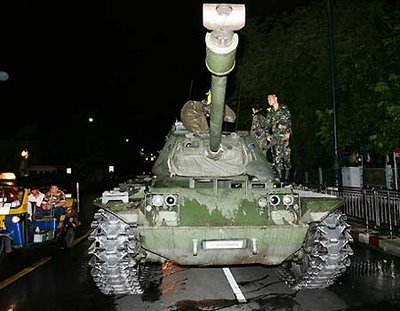
Just when I was beginning to become complacent about everyday life here in Bangkok, somebody goes and starts a Coup d'etat! Last night an unknown number of tanks, humvees, APCs, and soldiers moved in to central Bangkok and effectively removed Prime Minister Thaksin (and about a half dozen of his associates) from power. It was an entirely peaceful demonstration of the Thai version of democracy: The majority rural population votes in a right wing government and the Bangkok leftists find way to get rid of it. As of this morning there has still been no reported violence and the whole city seems completely calm and not nearly as disturbed as one might expect. My guess is that while this isn't the way they wanted Thaksin to go down, the people are happy to be rid of him, at least in the city.
The schools and Universities are closed today, and supposedly the King has declared this some strange form of National Holiday. Details are sketchy, but either way, I have little to do today but refresh the BBCNews homepage. The CNNInternational and BBCWorld cable news broadcasts were shutdown in this country shortly after midnight, and they have yet to return. All we have to watch now is a state controlled channel that is simply airing pictures of the King and patriotic songs, which occasionally have been subtitled in English for us.
UPDATE: The state controlled television networks have returned to air news in Thai. The cable news networks have not been returned, likely to prevent Thaksin from being able to make any statements to the Thai people.

Just when I was beginning to become complacent about everyday life here in Bangkok, somebody goes and starts a Coup d'etat! Last night an unknown number of tanks, humvees, APCs, and soldiers moved in to central Bangkok and effectively removed Prime Minister Thaksin (and about a half dozen of his associates) from power. It was an entirely peaceful demonstration of the Thai version of democracy: The majority rural population votes in a right wing government and the Bangkok leftists find way to get rid of it. As of this morning there has still been no reported violence and the whole city seems completely calm and not nearly as disturbed as one might expect. My guess is that while this isn't the way they wanted Thaksin to go down, the people are happy to be rid of him, at least in the city.
The schools and Universities are closed today, and supposedly the King has declared this some strange form of National Holiday. Details are sketchy, but either way, I have little to do today but refresh the BBCNews homepage. The CNNInternational and BBCWorld cable news broadcasts were shutdown in this country shortly after midnight, and they have yet to return. All we have to watch now is a state controlled channel that is simply airing pictures of the King and patriotic songs, which occasionally have been subtitled in English for us.
UPDATE: The state controlled television networks have returned to air news in Thai. The cable news networks have not been returned, likely to prevent Thaksin from being able to make any statements to the Thai people.
Tuesday, September 19, 2006
Weekend of Bad Wine and Bowling
Thursday night was the annual Wine Tasting Festival hosted by the Biotechnology department here at Assumption University. A somewhat dressy affair complete with plenty of finger food and a live band, this "wine tasting" was really an exhibition of what the biotechnology students had labored to produce: really really bad wine. Oh, but you bet we drank it. In fact, I think fifty percent of those who showed up to drink that night were Farang teachers at Assumption. It was an incredibly odd experience. Really awful (but consumable) red wine accompanied by excellent Thai finger foods and a band that, like virtually every other Thai band I've seen thus far, did not draw too much of a distinction between live music and Karaoke. All in all, thoroughly enjoyable. Here are some pictures of us having more fun than we probably should have been, and this Thai baby may or may not have gone home with us...


Friday night was perhaps slightly less odd, but no less fun. We went bowling, and this is one thing that the Thais don't seem to have made illogical. Bowling here is in fact even more efficient than it is in the states!! They have bowling shoe vending machines! If that's not an indication of an advanced civilization, I don't know what is. Here are a few pictures of Americans making asses of themselves at the lanes.





Friday night was perhaps slightly less odd, but no less fun. We went bowling, and this is one thing that the Thais don't seem to have made illogical. Bowling here is in fact even more efficient than it is in the states!! They have bowling shoe vending machines! If that's not an indication of an advanced civilization, I don't know what is. Here are a few pictures of Americans making asses of themselves at the lanes.


















